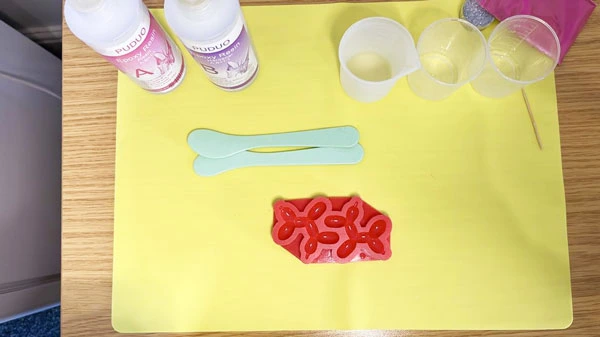Getting Started
Starting a new craft can be quite daunting. We ask ourselves all kinds of questions and get all in a tizzy. At least, I did when I decided to give resin a try. Some of the questions I asked myself were:
How long does it take to learn?
Is it too difficult?
What do I need?
Here’s the thing – resin is not a very difficult craft at all. As long as you can mix and measure, you’re pretty much fine from the start. In time, you’ll want to experiment with different techniques and materials, and that’s when the fun begins. Even if you end up making mistakes (goodness knows I have, plenty of times) you’ve just learned something for next time. No big deal.
Your Setup

To start with, you’ll need a workspace. It should be well-ventilated without being too cold and draughty. As I’m a poor Londoner with little space to my name, I use my desk and crank the windows as open as I can.
You’ll also want to avoid getting resin blobs all over your workspace. They’re not all that easy to remove once they cure. I didn’t want to kiss my rent deposit goodbye, so silicone mats for my desk were just the ticket. Baby wipes will also become your best friend as you use them to wipe off surfaces or reusable stirring sticks.
Other things you’ll need:
- resin (I use 2-part resin by Puduo or Dr. Resin for most of my projects)
- silicone mixing cups – they’re much better than plastic ones, and any leftover resin can be peeled out of them once it’s cured. Otherwise, hot soapy water will do the trick if the resin is wet
- Stirring sticks (silicone or plastic ones are great and easy to clean up with baby wipes)
- baby wipes (in case you need to wipe wet resin off your skin or any surfaces)
- acetone and paper towels (for removing any cured resin from surfaces)
- toothpicks (to pop any bubbles that rise to the resin surface)
- colourants (I recommend liquid resin dye if you want a transparent effect, and mica powder if you want the resin to be more opaque)
- extras (glitter, beads, or gold leaf are all lovely)
For information on safety tips and equipment, head over to the Safety page.
Basic Steps
Here are the most basic steps for creating resin art using 2-part resin:
- Pour equal parts of resin and hardener into measuring cups, then pour both into a mixing cup.
- Mix slowly and thoroughly for around five minutes, popping any bubbles with your mixing stick.
- Pour the mixed resin into the mould.
- Leave to cure. I always leave mine for around 24 hours, even if the instructions on the resin bottle say it takes much less time.
- Unmould.
Take a look at the Simple Moulds tutorial for a video on how to get started with resin.
Dos and Don’ts
While you’ll eventually get a feel for what does and doesn’t work through trial and error, here are some quick tips to keep in mind as you start your first projects.
Temperature
Your room temperature is important. The warmer the room, the faster your projects will cure. Ideally, your room temperature will be 23-30C during mixing and the curing process. Any colder than that, and there’s a chance that your work will take longer to cure. It’s also important that you store your resin at a nice, even room temperature. I like to think of it in terms of honey – when we store honey at a good room temperature, it’s an even, thick but runny consistency. If we pop it in the fridge, however, it becomes very thick and full of horrible bubbles. Treat your resin like a jar of honey.
Mixing
Make sure you mix your 2-part resin nice and slowly. Don’t whip away at it like you’re mixing cake batter, or you’ll get lots of bubbles in your projects. Most of the time, we don’t really want these. That said, make sure your resin is thoroughly mixed, or you’ll see streaks where the parts haven’t fully combined. I mix for around five minutes, and if I set it down for any reason, I’ll give it another mix for good measure.
Measuring
When measuring out your resin and hardener, make sure that they are exactly the same amounts. Use the lines on the measuring cups to guide you. If your amounts are not equal, you run the risk of your projects becoming gummy, or not curing properly at all.
Overfilling moulds
Fill the mould so that the resin is exactly level with the top. If it overlaps and spills over the top, you could end up with jagged edges that you’ll need to sand off once the resin is cured. This is a real pain, so it’s best to err on the side of caution. I pour, wait for the resin to settle, then add more in tiny amounts until it looks right.